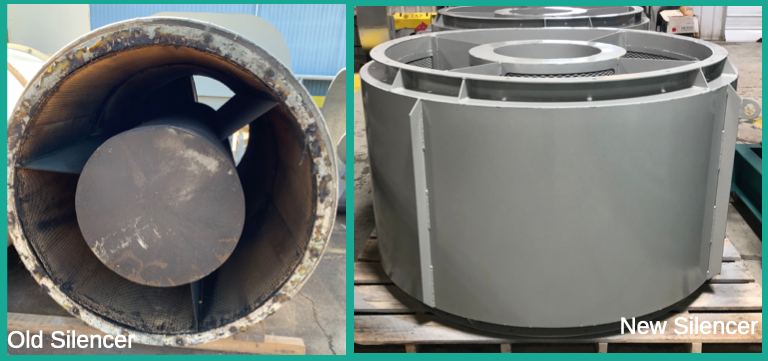When it comes to a gas turbine ventilation rebuild project, Eldridge has a vast amount of experience rebuilding the ventilation systems for both the turbine itself and the compartments enclosing the turbine and generator. We recently helped a customer with the rebuild of a gas turbine where we had originally designed the enclosure ventilation systems over 19 years ago. There were a number of unique criteria that made this rebuild project an exciting challenge for our design team.
Turbine Room Enclosure
Rebuilding ventilation systems for gas turbines usually begins with assessing the condition of the equipment. This is done to determine whether the components can be successfully rebuilt to their like new performance levels or whether they need to be replaced entirely. The existing turbine enclosure ventilation system was a gravity supply and powered exhaust type system with a silencer for noise abatement. We tested the belt drive vaneaxial fan and found that it only required new bearings and rebalancing of the propeller to continue to provide the require performance. However, the internal components of the silencer had significantly deteriorated and we recommended that it be replaced along with new stack caps.

Generator Room Enclosure
The customer was replacing the existing generator with a new, water cooled model. This meant that the air flow required for the generator room enclosure to dissipate heat was greatly reduced. The other significant change in the ventilation system was that the size and location of the exhaust damper and hood were changed to accommodate the new generator.
The challenge we faced in rebuilding the existing belt drive vaneaxial supply air fan was to select a propeller and sheave combination that would provide the reduced air flow at the new total static pressure. If we were to make selections that provided too little air flow, that might cause a heat overload on the generator. Too much air flow might cause doors to fly open and potentially injure someone.
Because there was both a change in air flow and geometry of the ventilation system, the only way to get the pressure drop right was to calculate it based on the pressure drop coefficient and air velocity for each component. With the correctly calculated total static pressure, we were able to select the right propeller and sheaves to deliver the required airflow.

Conclusion
Whether it is a change in the ventilation system requirements or the system geometry that makes a turbine ventilation rebuild project unique, we have the experience to handle the challenge. The Eldridge guarantee is that we can rebuild or replaced ventilation system components that will deliver the required air flow at the most economical cost. Our goal is to make your turbine rebuild project a complete success!
Be sure to check out our past articles related to anti-icing and ventilating Gas Turbines.
